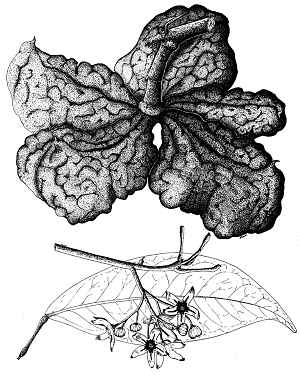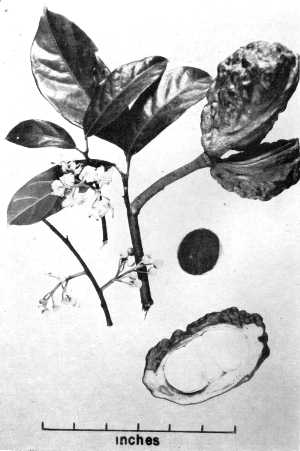Cola Nut, Kola
Scientific Name: Cola acuminata Schott & Endl.
Synonym: Sterculia acuminata
Family: Sterculiaceae
USDA: 11-12
Frost Tolerance: Container only in Phoenix
Sun Exposure: Full sun
Origin: West Africa
Growth Habits: Tree, 40 to 60 feet tall (12-18 m)
Watering Needs: Regular water
Propagation: Seeds, cuttings

Cola Nut (Cola acuminata), U.S.D.A. Drawing, courtesy Hunt Institute
The Cola Nut, a medium-sized tree native to West Africa, is now grown in many parts of the Tropics. Its bark is smooth. The leathery elliptic leaves are dark green, keeled at the midrib, and often twisted at the tip.
Blooming Habits:
The small flowers, which lack true petals, are borne in clusters of 10 to 15 in axillary and terminal panicles. The flowers are greenish-yellow or white and purple at the margins of the petals. Both male and perfect flowers are produced on the same inflorescence.
Fruiting Habits:
The fruit is a follicle, which is corky or rough on the surface and may be 8 inches (20 cm) in length. The ovoid or angular seeds are covered with a white skin that is thin but rather fleshy. Within the seedcoat the seeds are commonly red, but may be pink or white. The cotyledonsare tender and succulent but bitter in taste. Cola nuts are chewed for the stimulating effect of the alkaloids caffein and theobrominethey contain. The cola nut is widely grown in West Africa and has particular uses in the social life and religious customs of the people. In Nigeria and Cameroon, four species of cola with edible seed have been distinguished.
Cola extract is what gives their names to cola drinks.
Propagation:
The cola nut is usually propagated by seeds but can be propagated asexually by cuttings. The trees are slow growing and require 7 to 10 years to come into bearing. The trees, however, are long-lived and may bear fruit for 75 to 100 years.
Desert-Tropicals is dedicated to provide gardening advice, gardening ideas, and information about flower of all kind for landscape and collections.We try to check carefully the identification of the plants on the illustrations as well as the other information from the page, but occasionally errors do occur. if you notice anything that needs to be changed please contact us.Thanks.
© 1998-2020 Philippe Faucon, All Rights Reserved.
